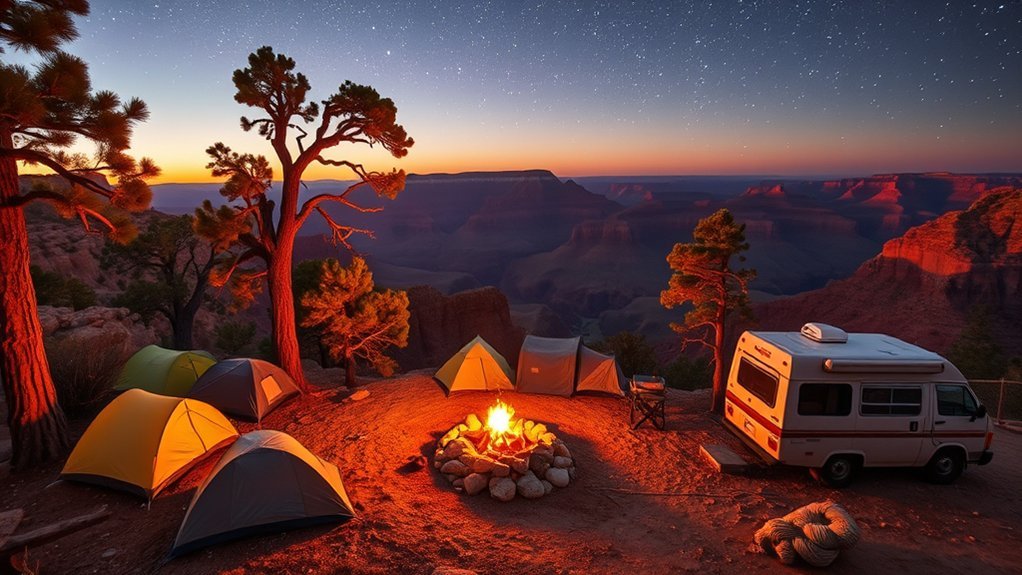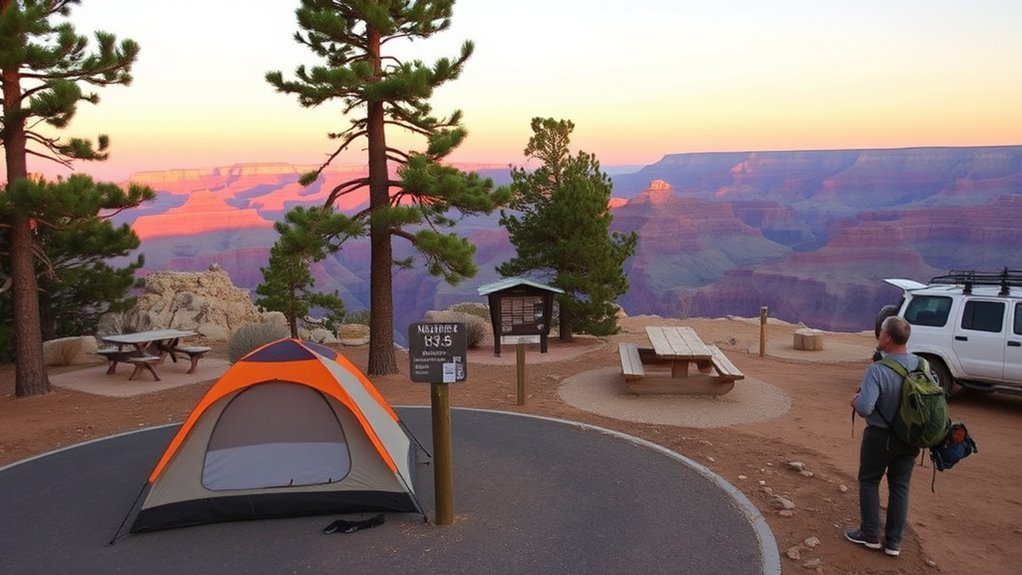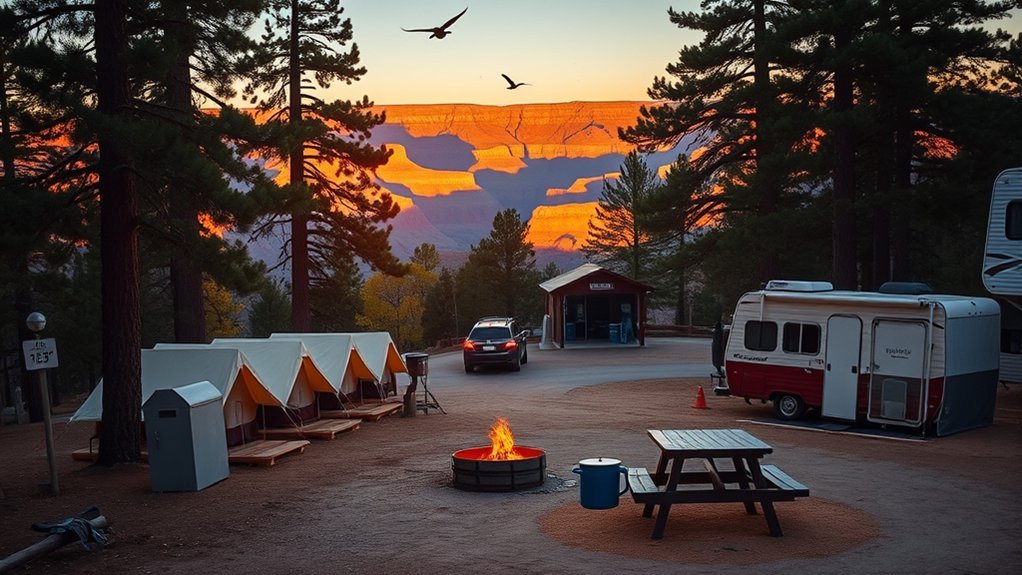About 90% of Grand Canyon visitors stick to the rim, so if you want a true backcountry experience you’ll need a plan. You’ll learn how to score a South Rim campsite, when to try walk‑up spots, and what permits and limits apply for below‑the‑rim trips — including essential water and food rules — so keep going to avoid common mistakes that can ruin a trip.
Why Choose the South Rim for Your Grand Canyon Camping Trip

Choosing the South Rim puts you at the heart of Grand Canyon access and services—it’s open year‑round, hosts the park’s primary visitor hub, and gives easy access to major viewpoints, shuttle buses, lodges, and trailheads like Bright Angel and South Kaibab. You’ll find the South Rim the most practical base for both tent campers and RVs: Mather Campground offers 300+ sites for tents and small rigs, while Trailer Village RV Park provides full hookups and sites up to 50 ft. Corridor access from the rim is unique—you’ll use Bright Angel Trail or South Kaibab Trail for day hikes or for starting backcountry trips, and the Backcountry Office on the rim handles backcountry permits and permit pickup. Services are concentrated and reliable: potable water, flush toilets, coin‑op laundry and showers, a park store and ranger info. Make campground reservations early—site availability tightens during peak season—but expect the South Rim to give you the widest range of canyon viewpoints and conveniences.
Reserve or Walk Up: How to Secure a South Rim Campsite

You should reserve Mather or Desert View online well in advance—Mather fills fast and Desert View has only about 50 sites—while Trailer Village RV hookups can be booked up to 13 months ahead through the concessionaire. If you’re trying a same‑day walk‑up, arrive by 8:00 a.m. during peak season for one of Mather’s ~15 day‑of spots, but don’t count on availability. Have backup options ready (private campgrounds or Kaibab Forest dispersed sites) and remember backcountry trips require a separate NPS permit.
Reserve Online Early
Frequently, the smartest move is to reserve your South Rim campsite well in advance—Mather and Desert View sites open on Recreation.gov up to six months ahead, while Trailer Village RV sites (the only ones with full hookups) are booked through the concessionaire at visitgrandcanyon.com up to 13 months out. You should secure reservations for Mather Campground and Desert View Campground as soon as your window opens, especially for holidays and long weekends. Trailer Village fills fastest; book there first if you need hookups. If you’re last-minute, monitor Recreation.gov for cancellations and arrive early at the first-come kiosk: Mather holds limited walk-up sites released at 8 a.m. Have alternate plans—nearby private or Forest Service backup campgrounds—to avoid being stranded.
Try Same-Day Walk-up
Often the quickest way to snag a South Rim campsite is to try the same‑day walk‑up option—Mather releases about 15 day‑of sites at 8:00 a.m. Arrive at the campground kiosk near opening, have your ID and payment ready, and be prepared to claim a site fast. Check Recreation.gov first for same-day reservations, but prioritize the kiosk for walk-up sites. If you miss backcountry permits online, visit the Backcountry Office in person to join the day-of waiting list. Trailer Village and Desert View rarely offer day-of availability, so use them only as long‑shot options. Always carry a backup camping plan—nearby private campgrounds or Forest Service dispersed camping—if the park fills.
| Option | Notes |
|---|---|
| Mather Campground | Best walk-up sites |
| Backcountry permits | In-person waiting list |
| Trailer Village | Low day-of availability |
Mather Campground: What to Expect and Practical Details

Settle into Mather Campground‘s shaded piñon‑juniper and ponderosa‑pine loops—over 300 sites sit about a mile from the South Rim and are available year‑round with reservations up to six months ahead on Recreation.gov. You’ll find standard sites with a picnic table and fire ring; bathrooms with running water and electrical outlets sit near loops, and potable water pumps plus green dumpsters handle waste and recycling. Check‑in is noon, check‑out 11 a.m.; maximum stay is seven consecutive days (30 days per calendar year). Site limits typically allow up to six people and two vehicles. Pets are allowed on leash but may not be left unattended outside vehicles. Mather has no hookups for trailers and RVs, though a dump station and nearby coin‑op showers and laundry help RV users; Trailer Village RV Park nearby offers full hookups. Buy firewood on site—don’t transport wood. Use reserved sites from Recreation.gov during busy season and plan accordingly for a smooth stay.
Desert View Campground: Location, Rules, and Best Uses
Located 26 miles east of Grand Canyon Village along Desert View Drive, Desert View Campground offers 50 shaded sites among piñon and juniper trees and serves as a quieter, more secluded alternative to Mather. You’ll find a seasonal campground typically open mid‑April through mid‑October; it closes for winter. Each site provides a picnic table and campfire ring, and the loop has flush toilets and sinks but only two water faucets and no showers. Reservations Recreation.gov are required and open up to six months ahead; book early if you want a specific site. Most sites handle tents and small RVs, but note the 30-foot RV limit—larger trailers won’t fit. Pets are allowed on leash, and the compact layout favors campers seeking solitude and easy access to Desert View Watchtower and eastern viewpoints. Manage your water, pack out waste, and follow fire regulations so this quieter option remains welcoming and sustainable.
Trailer Village RV Campground: Hookups, Size Limits, and Reservations
If you prefer full hookups and easy access to the South Rim village instead of the quieter, more rustic Desert View site, Trailer Village is the park’s dedicated RV campground with paved pull‑through sites that handle rigs up to 50 feet and provide water, sewer, and 30/50‑amp electrical service. You’ll get full RV hookups close to village services; sites include a picnic table, and pets must be leashed. Trailer Village is concessionaire‑operated—make reservations at www.visitgrandcanyon.com up to 13 months in advance. Check RV length limits when booking; site lengths and vehicle rules vary and check‑in/out is noon.
| Feature | Notes |
|---|---|
| Hookups | water sewer electrical, 30/50‑amp service |
| Site type | paved pull‑through sites, picnic table |
| Availability | open year‑round, reservations www.visitgrandcanyon.com (13 months in advance) |
Laundry and showers are limited on site; some services require a short drive to Mather Campground. Confirm your rig length to avoid surprises.
Backcountry Camping Below the Rim: Permits, Limits, and Strategy
Because overnighting below the rim requires a backcountry permit, you’ll need to plan well in advance—apply through the NPS Backcountry Office (or the Early Access Lottery) up to four months before your trip and expect fees and strict limits for Corridor campgrounds like Bright Angel, Indian Garden (Havasupai Gardens), and Cottonwood. You’ll pay $10 per permit plus $5 per person per night for below‑rim sites. Apply via the permit system, or submit Early Access Lottery entries by 5 p.m. MST on the 1st four months out.
You must submit requests in person at the Backcountry Information Center (South Rim hours 8 a.m.–noon and 1–5 p.m. MST), by fax, or by mail; phone and email aren’t accepted. Corridor campgrounds limit stays to two nights per campground per hike. If you miss out, visit the Backcountry Office to join the in‑person waiting list for cancellations and keep a contingency plan.
- Reserve early via Early Access Lottery.
- Factor permit fees into trip cost.
- Respect two‑night campground limits.
- Use in‑person waiting list for cancellations.
Bright Angel, Havasupai Gardens, and Cottonwood Campgrounds Explained
Think of Bright Angel, Havasupai Gardens, and Cottonwood as the three managed pit stops for overnighting below the South and North rims—each offers distinct services, spacing, and rules you need to plan around. Bright Angel Campground sits roughly 0.5 mile from the Colorado River near Phantom Ranch and Bright Angel Creek; it’s the only year‑round canyon‑floor site with drinking water, toilets, and ranger staffing. Havasupai Gardens(Indian Garden) lies about 4.6–4.8 miles down the Bright Angel Trail from the South Rim, providing shade, drinking water, composting toilets, and food‑storage canisters—common as a first overnight for rim‑to‑river hikers. Cottonwood Campground, about 6.8 miles down the North Kaibab Trail from the North Rim and ~4,170 ft below rim, offers seasonal potable water (mid‑May to mid‑October), toilets, and an emergency phone. All three require a Backcountry Permit (fees apply, two‑night max per site); obtain permits through the Backcountry Office in person, by fax, or by mail, and use the Early Access Lottery or contingency planning because demand is high.
Packing, Water, Food Storage, and Safety for Rim-to-River Trips
Now that you know where the managed camps are and how permits work, you’ll need to outfit yourself for the steep, hot descent and the cold climb back out. For rim-to-river trips carry 3–4 liters per person and refill only at known faucets (Bright Angel, Indian Garden, Phantom Ranch); treat or filter any unconfirmed drinking water. Get a backcountry permit well in advance and note two-night limits at corridor sites.
Now that camp locations and permitting are set, pack 3–4 L water, treat refills, and bring layered gear.
Plan food and storage: high-calorie, non-perishables for the ascent, plus park-approved containers or canisters at Bright Angel, Indian Garden, and backcountry sites to prevent wildlife problems and fines. Pack layered clothing for big temperature swings, sturdy footwear, sun protection, headlamp, and a first-aid kit. Tell someone your route; expect limited cell service on the trail.
- Water: 3–4 L, refill at named faucets, treat if unsure.
- Food: calorie-dense, extra for ascent.
- Storage: approved containers/lockboxes required.
- Safety: layers, light, footwear, notify contacts.
Nearby Private and Forest Service Campgrounds as Backup Options
If park campgrounds are full, you can turn to nearby private parks like Grand Canyon Village RV Park and Camper Village for tent and RV sites with services some NPS sites lack. You’ll also find Kaibab National Forest options—from the ~70-site Ten‑X campground to free dispersed spots along Long Jim Loop and Forest Road 688—but these are first‑come, first‑served and often have no water or hookups. Check rules, reservation windows, vehicle limits, seasonal closures, and fees before you go so you choose the right backup.
Private Campground Options
When park campgrounds are full, nearby private and Forest Service options keep you camping close to the South Rim—Grand Canyon Village RV Park & Campground and Grand Canyon Camper Village sit within a mile or so of the South Entrance and offer reservable sites and services you won’t find inside the park, while Kaibab National Forest campgrounds (Long Jim Loop, Ten‑X/Tusayan‑Montane, and sites along Forest Service Road 688/Coconino Rim Road) provide fee and first‑come alternatives ranging from dispersed RV spots to 70‑site non‑electric campgrounds.
- Check private RV parks for reservations and hookups before you arrive.
- Use Grand Canyon Camper Village or Grand Canyon Village RV Park & Campground for RV-friendly full‑service sites.
- For cheaper options, drive into Kaibab National Forest; Long Jim Loop offers first-come dispersed RV-friendly spots.
- Arrive early for Tusayan-Montane or FSR 688 first-come sites; bring water and pack out waste.
Forest Service Sites
Forest Service sites and nearby private campgrounds give you practical backup when park campgrounds are full, offering everything from free dispersed boondocking to reservable RV hookups just outside the South Entrance. You can choose from options on Kaibab National Forest lands and nearby private parks near Tusayan. Long Jim Loop is an RV-friendly, free dispersed camping area about 1–1.5 miles from the South Entrance with no hookups — plan accordingly. Ten-X Campground (Tusayan‑Montane) sits ~2 miles south of Tusayan with roughly 70 non-electric sites and potable water (not for RV fill); it closes seasonally. Along Forest Service roads and sites you’ll find dispersed camping and first-come first-served spots; bring supplies, follow Leave No Trace, and expect limited services.
Dispersed Camping Tips
Alongside park campgrounds, dispersed sites on Kaibab and nearby forest lands give you flexible backup when reservations aren’t available. You’ll find dispersed camping near the South Rim that’s primitive, first‑come first‑served, and ideal if you’re prepared to boondock. Expect no hookups, no water, limited cell service, and strict Leave No Trace rules.
- Long Jim Loop — 1.4 miles south of the South Rim entrance; free, RV‑friendly but no hookups; sites fill early.
- Forest Road 688 — about 5.4 miles from the South Rim entrance; ~20 non‑reservable sites; no services.
- Coconino Rim Road (FR 310) — close primitive boondocking; bring water, pack out trash.
- Saddle Mountain Overlook — nearest North Rim option; five non‑reservable sites; suitable for big rigs.
Arrive early in peak season and don’t transport firewood.
Frequently Asked Questions
How to Prepare for Backcountry Camping?
Prepare by getting a backcountry permit early, packing layered clothing, sun protection, and 3–4+ liters water per day, carrying a filter, securing food in provided canisters, limiting nights per campground, and having contingency plans.
What Is the #1 Rule of Grand Canyon Hiking?
Stay safe: the number one rule is don’t overexert — start early, sip sufficient fluids, stick to your turnaround time, stay with a partner, and summon help if needed so you avoid risky, reckless canyon consequences.
What Is the Best Grand Canyon Campground?
Mather Campground is the best overall choice for first-time South Rim visitors — you’ll get proximity to services, water, restrooms, showers and reservations via Recreation.gov, balancing convenience, amenities, and great rim views for tent or RV camping.
How to Get Backcountry Camping Permit in Grand Canyon?
About 75% of backcountry nights fill via the early lottery, so apply through the NPS Backcountry Office (in person, fax, or mail) using the Early Access Lottery window, pay fees, or join the in-person waiting list.
Conclusion
You’ll leave the rim’s organized comfort—reserved sites, hookups, clear rules—for the canyon’s raw challenge, where permits, water planning, and stern limits decide success. Plan and reserve where you can, arrive early for walk‑ups, and carry layered clothing, headlamp, and ample water. Respect storage rules and Leave No Trace. Balancing convenience with wilderness responsibility lets you savor sunsets from an RV or earn dawn at the river—both are Grand Canyon wins.

